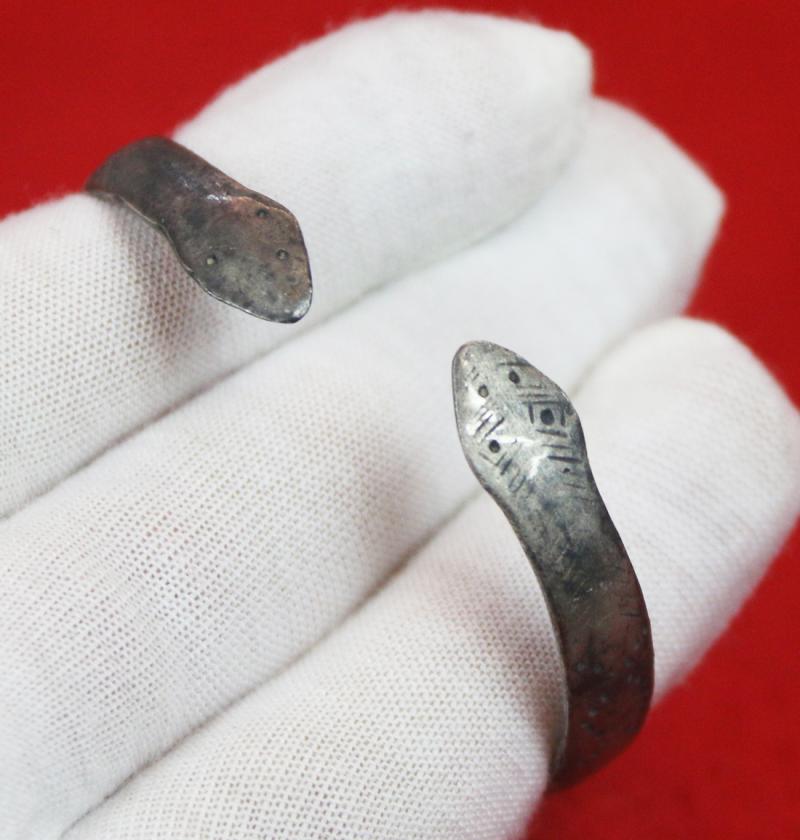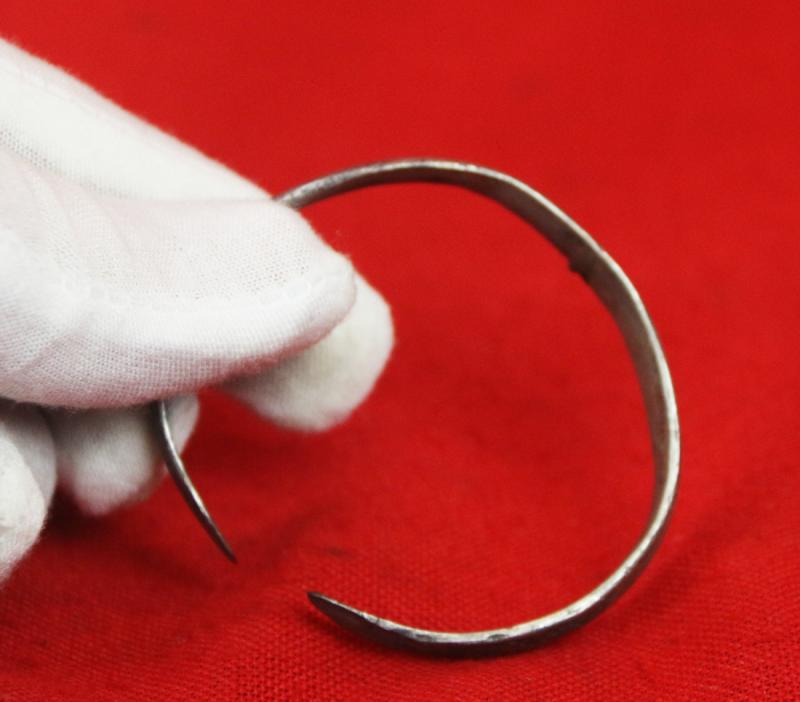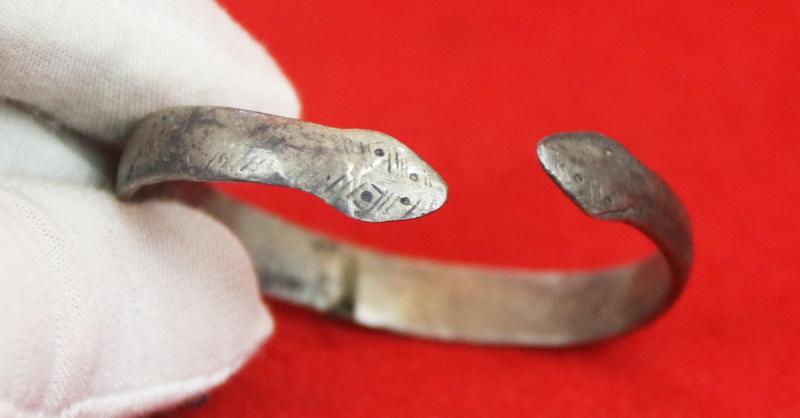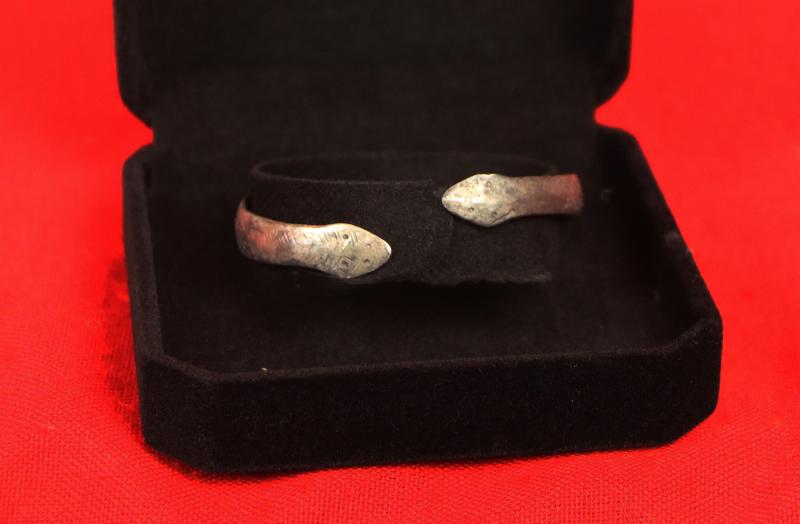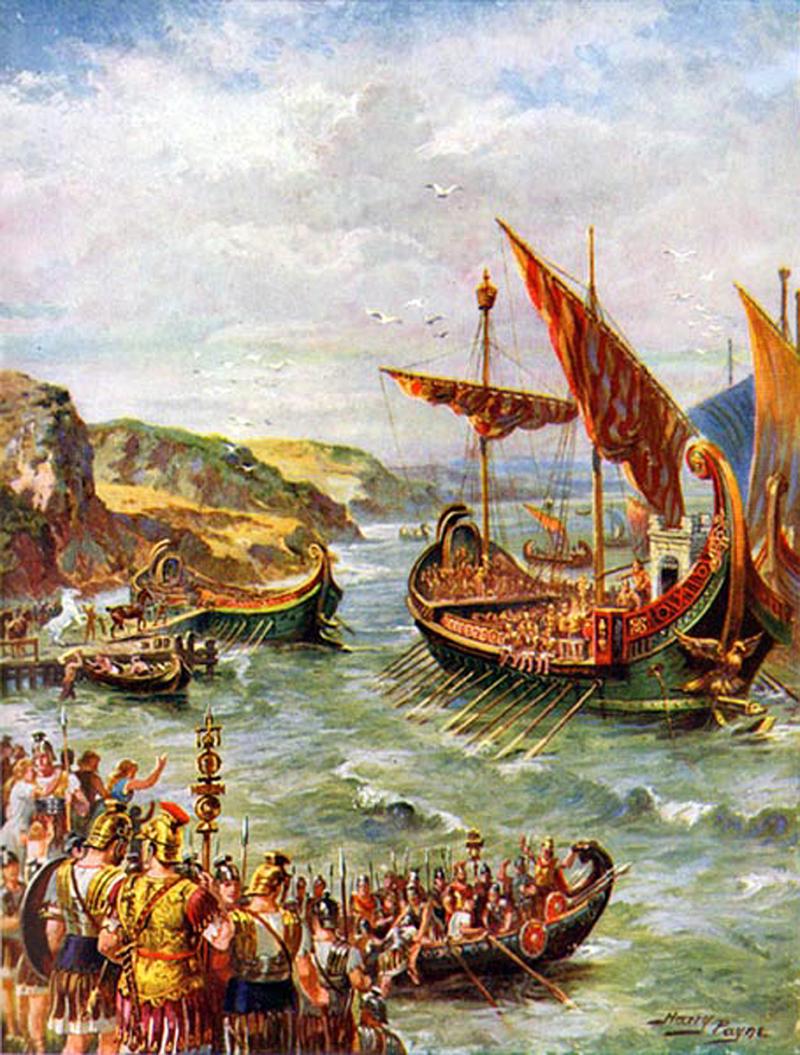A Superb, Silver, Ancient Romano-Celtic Serpent Armilla Bracelet, 1st Century Around 2000 Years Old. From the Celtic Iceni War With Rome
An ancient Roman serpent head armilla bracelet from Britain during the time of Boudicca, queen of the Iceni's, rebellion against Roman. Silver was a restricted metal of adornment for those only of suitably high rank in the Roman military and citizenry. For example, for centuries even the most superior Romans were only permitted to be buried with a total of less than one ounce of gold jewellery within their tomb.
Armillae were either gold, silver or bronze. The status of the recipient appears to have determined whether he would be granted a gold armilla or the lesser silver. Bronze armillae were given as awards for distinguished conduct to soldiers of lesser rank, but were valued no less highly for the prestige they conferred upon their owners. Armillae were usually awarded in pairs and a soldier could win more than one pair. They were not for everyday wear, but generally only worn at military parades or on dress uniform occasions like a general's Triumph, though they could also be worn at certain civic events like religious ceremonies and the games.
Military armillae were modelled on those worn by the Celts. The tradition of using Celtic-style torcs and armillae as Roman military decorations had its beginnings in 361 BC when Titus Manlius Torquatus (consul 347 BC) slew a Gallic chieftain of impressive size in single combat. He then stripped the bloodstained torc from the corpse's neck and placed it around his own as a trophy. The Romans were initially daunted by the fearsome appearance of the Gauls, whose elite warriors were "richly adorned with gold necklaces and armbands". The torc was the Celtic symbol of authority and prestige. By his action, Torquatus in effect took the vanquished chieftain's power for his own, and created a potent, visible token of Roman domination. As such, over time the torc and also the armilla were adopted as official awards for valour, taking on the role of symbolic war trophies Military armillae were modelled on those worn by the Celts. The tradition of using Celtic-style torcs and armillae as Roman military decorations had its beginnings in 361 BC when Titus Manlius Torquatus (consul 347 BC) slew a Gallic chieftain of impressive size in single combat. He then stripped the bloodstained torc from the corpse's neck and placed it around his own as a trophy. The Romans were initially daunted by the fearsome appearance of the Gauls, whose elite warriors were "richly adorned with gold necklaces and armbands". The torc was the Celtic symbol of authority and prestige. By his action, Torquatus in effect took the vanquished chieftain's power for his own, and created a potent, visible token of Roman domination. As such, over time the torc and also the armilla were adopted as official awards for valour, taking on the role of symbolic war trophies.
Armillae were made in a substantial masculine style and produced in a variety of designs: a solid, hinged cuff, sometimes inscribed with legionary emblems or decorated with incised patterns; an open-ended spiral; a chunky, rounded bracelet with open or overlapping ends; or a torc in miniature. Armillae which were open-ended or had overlapping ends often featured knobs or snake-heads as terminals
The Iceni or Eceni were an Iron Age Celtic tribe living in the British Isles prior to the Roman invasion of Britain. Their territory included present-day Norfolk and parts of Suffolk and Cambridgeshire. Julius Caesar does not mention the Iceni in his account of his invasions of Britain in 55 and 54 BC, though they may be the Cenimagni or Ceni Magni, whom Caesar noted as living north of the River Thames.
The Iceni tribe occupied all of Norfolk and north-west Suffolk. They were a monarchic society state, geographically separated from their western neighbours the Coritani by uninhabitable fenland. They were bordered to the south by the Atrebates.
While the meaning of the name Iceni is unknown, it is tempting to see it as derived from a Proto-Celtic adjective cognate with Latin picea ‘pine tree,’ the Italic tribal name Piceni, English picene, and with the English hydronym Itchen. Icenian coins dating from the 1st century AD use the spelling ECEN, which probably suggests a different etymology.
Tacitus records that the Iceni were not conquered in the Claudian invasion of AD 43, but had come to a voluntary alliance with the Romans. However, they rose against them in 47 after the governor, Publius Ostorius Scapula, threatened to disarm them. The Iceni were defeated by Ostorius in a fierce battle at a fortified place, but were allowed to retain their independence. The site of the battle may have been Stonea Camp in Cambridgeshire.
A second and more serious uprising took place in AD 61. Prasutagus, the wealthy, pro-Roman Icenian king, had died. It was common practice for a Roman client king to leave his kingdom to Rome on his death, but Prasutagus had attempted to preserve his line by bequeathing his kingdom jointly to the Emperor and his own daughters. The Romans ignored this, and the procurator Catus Decianus seized his entire estate. Prasutagus’s widow, Boudica, was flogged, and her daughters were raped. At the same time, Roman financiers called in their loans. While the governor, Gaius Suetonius Paulinus, was campaigning in Wales, Boudica led the Iceni and the neighbouring Trinovantes in a large-scale revolt, destroying and looting Camulodunum (Colchester), Londinium (London) and Verulamium (St Albans) before finally being defeated by Suetonius Paulinus and his legions. Although the Britons outnumbered the Romans greatly, they lacked the superior discipline and tactics that won the Romans a decisive victory. The battle took place at an unknown location, probably in the West Midlands somewhere along Watling Street. Today, a large statue of Boudica wielding a sword and charging upon a chariot can be seen in London on the north bank of the Thames by Westminster Bridge.
Archaeological evidence of the Iceni includes torcs — heavy rings, bracelets, armlets and torcs of gold, silver, electrum or bronze, worn around the neck and shoulders. The Iceni began producing coins circa 10 BC. Their coins were a distinctive adaptation of the Gallo-Belgic “face/horse” design, and in some early issues, most numerous near Norwich, the horse was replaced with a boar. Some coins are inscribed ECENI, making them the only coin-producing group to use their tribal name on coins. The earliest personal name to appear on coins is Antedios (ca. 10 BC), and other abbreviated names like AESU and SAEMU follow.
As with all our items it comes complete with our certificate of authenticity. 2.25 inches wide just under 19 gms silver weight.
Code: 24780
995.00 GBP


